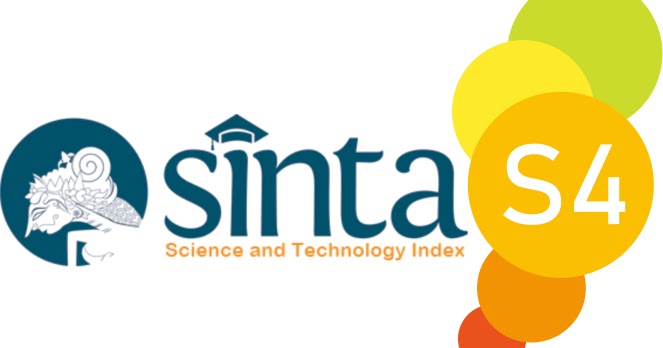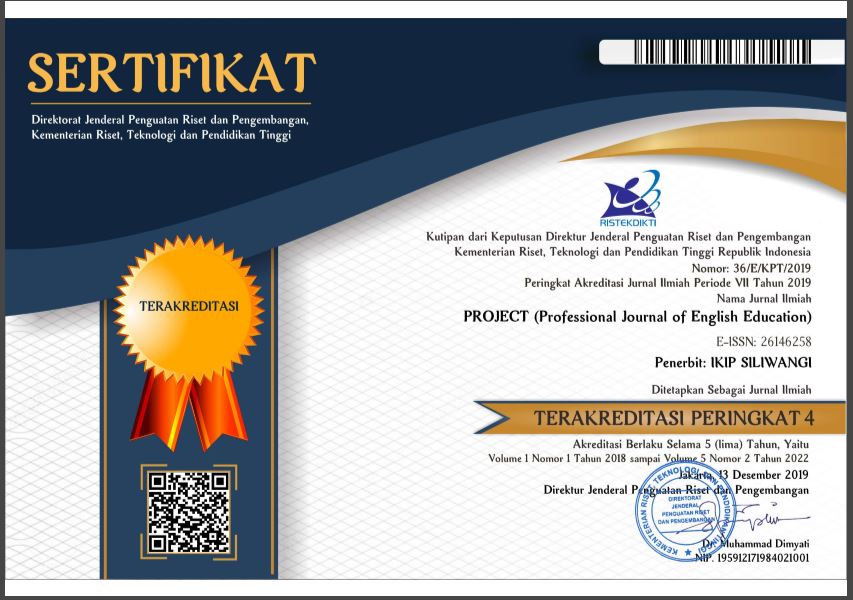AI Writing Assistants: Insights from EMI Higher Education
Abstract
One of the requirement of study in an EMI university is the ability to express ideas through academic writing tasks or projects. This explanatory study aims to investigate EMI university students' strategies of using artificial intelligence-based writing assistants for college writing tasks. This mixed-method study combined survey-based instrument and interviews. The survey was distributed online, consisting of 10 likert scale statements, with 1 = strongly disagree and 5 = strongly agree and 5 close-ended questions. This likert-scale statements seek to map students’ use of AI-based writing assistants in stages of writing process while the close-ended questions seek to explain their perceptions of using AI writing assistants. This questionnaire was followed by interviews to several participants, purposively selected based on their responses in the questionnaire. The survey was distributed to 101 university students from 17 study programs at one university that implements EMI. The results revealed that AI tools support EMI students throughout the whole stages of writing processes, but mainly in pre-writing, drafting, and editing stages. Furthermore, students’ positive views over the support and concerns over significant reliance on the use of AI writing assistants are also discussed. Further research could investigate the long-term effects of using these tools on students' academic writing skills and academic performance.
References
Alfaki, I. M. (2015). University students’ English writing problems: diagnosis and remedy. International Journal of English Language Teaching, 3(3), 40–52.
Alkaissi, H., & McFarlane, S. I. (2023). Artificial Hallucinations in ChatGPT: Implications in Scientific Writing. Cureus, 15(2). https://doi.org/10.7759/cureus.35179
Allen, L. K., & McNamara, D. S. (2017). Five building blocks for comprehension strategy instruction. In Reading Comprehension in Educational Settings (pp. 125–144).
Creswell, J. W. (2015). Educational Research: Planning, Conducting, and Evaluati ng Quantitative and Qualitative Research (FIFTH EDIT).
Doloksaribu, N., & Simanjuntak, D. C. (2021). Students’ Perspective and Experience on the Use of English As Medium of Instruction in Introduction To Business Class: a Qualitative Interview Study. PROJECT (Professional Journal of English Education), 4(2), 230–243. https://doi.org/10.22460/project.v4i2.p230-243
Fenton-Smith, B., & Humphreys, P. (2017). Language specialists’ views on the academic language and learning abilities of English as an additional language postgraduate coursework students: towards an adjunct tutorial model. Higher Education Research and Development, 36(2), 280–296. https://doi.org/10.1080/07294360.2016.1185397
Karisma, C. I., & Lestari, S. (2023). EFL New University Students ’ Strategies To Cope With Writing For Academic Purposes In Online. PROJECT (Professional Journal of English Education, 6(1), 95–105.
Kim, J., & Cho, Y. H. (2023). My teammate is AI: understanding students’ perceptions of student-AI collaboration in drawing tasks. Asia Pacific Journal of Education, 1–15. https://doi.org/10.1080/02188791.2023.2286206
Kim, J., Yu, S., Detrick, R., & Li, N. (2024). Exploring students’ perspectives on Generative AI-assisted academic writing. Education and Information Technologies, 1–36. https://doi.org/10.1007/s10639-024-12878-7
Laksmi, E. (2006). Scaffolding students writing in EFL class: implementing process approach. TEFLIN Journal, 17(2), 125–156.
Luckin, R., Holmes, W., Griffiths, M., & Forcier, L. B. (2016). Intelligence Unleashed: An argument for AI in Education. In UCL Knowledge Lab: London, UK. Pearson. https://www.pearson.com/content/dam/corporate/global/pearson-dot-com/files/innovation/Intelligence-Unleashed-Publication.pdf
Lund, B., & Wang, T. (2023). Chatting about ChatGPT: How May AI and GPT Impact Academia and Libraries? Library Hi Tech News, 40(3), 26–29. https://doi.org/10.2139/ssrn.4333415
Malik, A. R., Pratiwi, Y., Andajani, K., Numertayasa, I. W., Suharti, S., Darwis, A., & Marzuki. (2023). Exploring Artificial Intelligence in Academic Essay: Higher Education Student’s Perspective. International Journal of Educational Research Open, 5(August), 100296. https://doi.org/10.1016/j.ijedro.2023.100296
Mansoor, M. N., & Al-Tamimi, M. S. H. (2022). Computer-based plagiarism detection techniques: A comparative study. International Journal of Nonlinear Analysis and Applications, 13(November 2022), 2008–6822. http://dx.doi.org/10.22075/ijnaa.2022.6140
Nurmayanti, N., & Suryadi, S. (2023). The Effectiveness Of Using Quillbot In Improving Writing For Students Of English Education Study Program. Jurnal Teknologi Pendidikan: Jurnal Penelitian Dan Pengembangan Pembelajaran, 8(1), 32–40. https://doi.org/10.33394/jtp.v8i1.6392
Raheem, B. R., Anjum, F., & Ghafar, Z. N. (2023). Exploring the Profound Impact of Artificial Intelligence Applications (Quillbot, Grammarly and ChatGPT) on English Academic Writing: A Systematic Review. International Journal of Integrative Research (IJIR), 1(10), 599–622. https://doi.org/10.59890/ijir.v1i10.366
Reguig, Y. and, & Mouffok, A. I. (2023). reguig [Université IBN KHALDOUN-Tiaret).]. http://dspace.univ-tiaret.dz/bitstream/123456789/13213/1/Reguieg and Mouffok %28corrected work%29.pdf
Tajik, M. A., Akhmetova, G. Y., Fillipova, L. N., Shamatov, D. A., & Zhunussova, G. D. (2022). Students’struggles With Emi In Kazakhstani Universities. Образование И Наука, 24(8), 95. https://doi.org/10.17853/1994-5639
Tlili, A., Shehata, B., Adarkwah, M. A., Bozkurt, A., Hickey, D. T., Huang, R., & Agyemang, B. (2023). What if the devil is my guardian angel: ChatGPT as a case study of using chatbots in education. Smart Learning Environments, 10(1). https://doi.org/10.1186/s40561-023-00237-x
Van den Berghe, R., Verhagen, J., Oudgenoeg-Paz, O., van der Ven, S., & Leseman, P. (2019). Social Robots for Language Learning: A Review. Review of Educational Research, 89(2), 259–295. https://doi.org/10.3102/0034654318821286
Downloads
Published
Issue
Section
License

This work is licensed under a Creative Commons Attribution-ShareAlike 4.0 International License.




